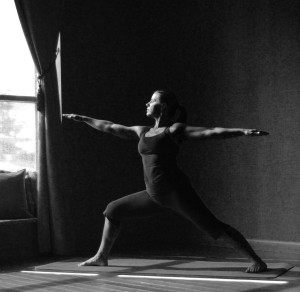 Today it is generally understood that body language is a big part of how we communicate and therefore plays a significant role in how we are perceived by others. According to the research of Albert Mahrebian, communication is 55% body language, with an additional 38% attributed to tone of voice, totalling a whopping 93% as non-verbal. This leaves 7% of communication to our actual words. However, affirmations and other forms of self-talk continue to dominate the world of self-help. If how we talk to ourselves has been shown to have an impact on how we perceive ourselves, then given the percentages above, body language should have a comparatively massive impact. This is the very line of thinking that Amy Cuddy, a social psychologist at Harvard Business, put to the test when she asked, “Do our non-verbals govern how we think and feel about ourselves, and if so how do we use this information to have a positive effect?“
Today it is generally understood that body language is a big part of how we communicate and therefore plays a significant role in how we are perceived by others. According to the research of Albert Mahrebian, communication is 55% body language, with an additional 38% attributed to tone of voice, totalling a whopping 93% as non-verbal. This leaves 7% of communication to our actual words. However, affirmations and other forms of self-talk continue to dominate the world of self-help. If how we talk to ourselves has been shown to have an impact on how we perceive ourselves, then given the percentages above, body language should have a comparatively massive impact. This is the very line of thinking that Amy Cuddy, a social psychologist at Harvard Business, put to the test when she asked, “Do our non-verbals govern how we think and feel about ourselves, and if so how do we use this information to have a positive effect?“
Cuddy, who had been interested in non-verbal expressions of power and dominance for some time, began to wonder one day about the relationship of class participation and posture in her students, since participation was a significant factor in their final grade. She noticed that the women tended towards postures of submissiveness, making themselves small and contained, and that the men tended toward postures of dominance and power, spreading out to fill up space. Coupled with the knowledge that some postures are innate, ancient, and tied to our very human nature, Cuddy was compelled to design an experiment where she asked participants to take on a high-power pose for 2 minutes. She then measured their subjective sense of power, their willingness to take risks, and took saliva samples. What she found is quite astonishing and compelling.
The Findings
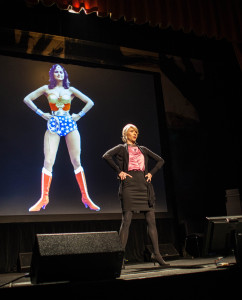
First, it is important to understand that there are two key physiological differences between powerful and powerless people; testosterone, the dominance hormone, and cortisol, the stress hormone. High power males in primate hierarchies, and powerful effective human leaders, all have high testosterone and low cortisol. This shows an ability to exert power over one’s environment and also a high tolerance to stress. In other words, power is about how you react to stress as much as it is about feelings of dominance and power.
Cuddy’s study revealed definitively that, “In two minutes you can significantly change your brain so that you are either assertive, confident and comfortable, or highly stress reactive and feeling shut down.” A 20% increase in testosterone for high-power (H-P) postures and 10% decrease for low-power (L-P) was measured. Also, Cortisol went down about 25% in H-P and up 15% in L-P, and perceived power and willingness to take risks went up in the H-P pose group.
In this small study Cuddy was able to show that not only do our minds change our bodies, but is it also true that our bodies change our minds. When you feel more powerful you are more likely to display powerful postures. Also, when you assume postures associated with power you end up feeling more powerful, even on a physiological level.
At this point you may be thinking, “This is all well and good but what kind of impact does this have in the real world, and how does this benefit me?” Well, I’m glad you asked . . .
Applying It!
While I don’t recommend a dramatic display of power posing during a job interview, I would recommend taking a posture of power for a few minutes before. In a subsequent study, Cuddy was able to demonstrate that high-power postures have a huge impact on one’s perceived level of presence, including qualities such as confidence, authenticity, and enthusiasm. If you remember the earlier statistic that 93% of our communication is non-verbal, it is not hard to see that these qualities have been shown to be the defining factors in decision making for hiring.
If like many, you are concerned that you will feel like an imposter if you“fake it until you make it,” fear not! Cuddy’s research supports the idea that what you are actually doing is faking it until you become it. Most people are in fact capable of rising to the challenge in front of them, and the main things holding them back are their beliefs about themselves. Furthermore,
As you continue to spend time in postures of power, your body and brain change to become more capable, powerful, and tolerant of stress; you are literally becoming it.
The Power Gender Bias
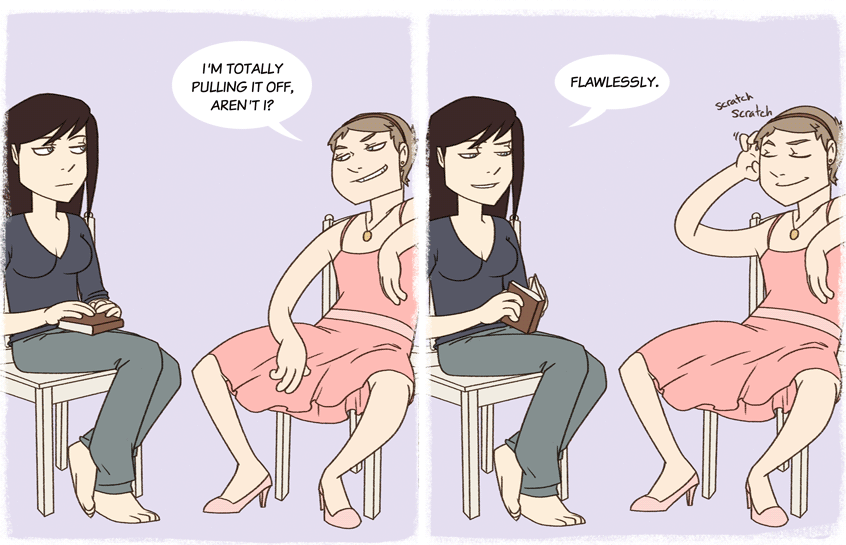
There is a long history of power inequality in this country divided along gender lines. While women have made great strides in this area, there are still hidden unconscious messages and ways in which feminine power is restrained. Philosopher Sandra Lee Bartky made the following observation about how being feminine often means using one’s body to portray powerlessness:
A feminine person keeps her body small and contained; she makes sure that it doesn’t take up too much space or impose itself. She walks and sits in tightly packaged ways. She doesn’t cover the breadth of the sidewalk or expand herself beyond the chair she occupies.
Likewise, loud activities that take up space and show power, such a burping, spreading out in a chair, standing tall, or even laughing loudly, are considered unfeminine. Bartky again writes, “Massiveness, power, or abundance in a woman’s body is met with distaste.”
Acting “feminine,” then is seen as submissive. Both men and women use their bodies in more submissive ways, for example when interacting with a superior, whether it be their boss, their commander, a police officer, or their professor. In my opinion, this gender bias is a hidden vestige of our history of patriarchy. What is needed now is an uncoupling of gender and posture altogether.
We need to seek to empower the feminine and encourage women of all ages to stand in and embody their power, instead of shying away from it; to accept that there is feminine power and acknowledge that it has great beauty.
It is also important to note that some see masculine and feminine postures of power as distinct. For example, postures involving a focus on the upper body with the chest out and arms up could be experienced as having a masculine quality of power. Postures focusing on the lower part of the body with hips low and legs bent, such as certain postures in Tai Chi, might be experienced as having a more feminine quality of power. We all have both masculine and feminine energies within us and I encourage you to explore both and examine how you feel afterward.
Power Posing 101
Now that you have a foundation of knowledge around how our bodies impact our minds and how we perceive ourselves, you are ready to start power posing. This may sound cheesy, but remember . . . it’s science! Power posing takes just a few minutes a day, so what do you have to lose?
The Foundation
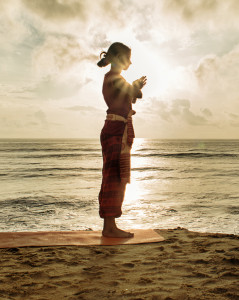 Before we dive into the postures you can use to feel more powerful, confident, and secure, let’s go over the foundation to any powerful posture. You can start either by standing still, sitting, or walking. I recommend standing to start.
Before we dive into the postures you can use to feel more powerful, confident, and secure, let’s go over the foundation to any powerful posture. You can start either by standing still, sitting, or walking. I recommend standing to start.
Now, tuck your chin a little and hold your head high, as if there were a string attached to the very top of your head elongating and strengthening your spine. Gaze forward with your eyes looking straight ahead. Relax your shoulders and drop the shoulder blades slightly down and back, and stick out your chest just a bit. It might help to shrug your shoulders up and down a few times before allowing them to relax in a position that feels natural. Space your feet hip-distance apart with your knees slightly bent and toes pointed ahead. Now relax your hips if you are clenching. You can imagine yourself deeply rooted in the ground through your feet. This is the foundation of power.
If the very notion of feeling powerful frightens you or makes you feel uncomfortable, remember that power does not have to be power over, but instead power with. True power is embodied in leaders that build a deep connection with others through honesty, humility, and a sincere desire to see and celebrate the other. Don’t shy away from your own innate power.
Postures of Power
Try these poses for two minutes each and observe how you feel after and throughout the day. Notice which ones have the biggest impact on your sense of power, confidence, and stress tolerance.
The Victory Pose
 This is one of the most innate postures within the human race. Athletes born without sight make the same stance of pride and victory when they win a competition as everyone else, though they have never seen it modeled. Try this the next time you have even a small success, such as remembering to bring your own bags to the supermarket . . . VICTORY!
This is one of the most innate postures within the human race. Athletes born without sight make the same stance of pride and victory when they win a competition as everyone else, though they have never seen it modeled. Try this the next time you have even a small success, such as remembering to bring your own bags to the supermarket . . . VICTORY!
Wonder Woman/Peter Pan
 This pose is one of my personal favorites. It is also one that can be used during certain interactions without calling too much attention to it. Try it the next time you are about to play a sport or do anything performance related.
This pose is one of my personal favorites. It is also one that can be used during certain interactions without calling too much attention to it. Try it the next time you are about to play a sport or do anything performance related.
Rooted
 Various forms of this posture can be found in martial arts and movement practices such as Tai Chi and Yoga. The basic form includes taking a wide open hip stance, lowing the hips, and bending the knees to create a sense of rootedness and stability. Your arms can be outstretched at your sides with palms out, in front of you, and on your thighs. For more practice I recommend taking a martial arts class such as Aikido or a movement practice like Tai Chi or Chi Gong.
Various forms of this posture can be found in martial arts and movement practices such as Tai Chi and Yoga. The basic form includes taking a wide open hip stance, lowing the hips, and bending the knees to create a sense of rootedness and stability. Your arms can be outstretched at your sides with palms out, in front of you, and on your thighs. For more practice I recommend taking a martial arts class such as Aikido or a movement practice like Tai Chi or Chi Gong.
Relaxed Open Sitting
This posture can also be incorporated into your life. Experiment with the way you sit and how it impacts you. Crossed legs, hunched shoulders, and a hand on neck or face are all signs that it might be time to experiment with the way you sit and how it impacts you.
The CEO
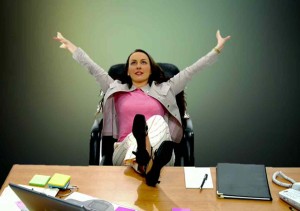 This pose shows up a lot with people in positions of power in the work environment. However, it is not copyrighted! Feel free to put your feet on your desk, fold your hands behind your head, and let out a big sigh and a smile J
This pose shows up a lot with people in positions of power in the work environment. However, it is not copyrighted! Feel free to put your feet on your desk, fold your hands behind your head, and let out a big sigh and a smile J
These are just a few of the potential postures of power. I encourage you to experiment. If you need more inspiration, I encourage you to take a yoga class. Warrior 1, 2, & 3 are wonderful postures of power and vitality.
To learn more about Amy Cuddy and her research into how the body changes the mind, you can check out her incredibly popular Ted Talk, Your Body Language Shapes Who You Are.
If you find that there are internal blocks to your ability to feel powerful, despite trying these postures, or you want to speed up your sense of empowerment, I encourage you to reach out to a counselor. Having your own innate power and worth mirrored back to you, and bringing healing to the places you had power taken away, can have a profound and lasting impact.
Thank you for reading. I encourage and appreciate questions, feedback, and stories of how this is impacting your life.
Sincerely,
Dan Entmacher, M.A., LPCc
photo credit: Hands in the air… via photopin (license)

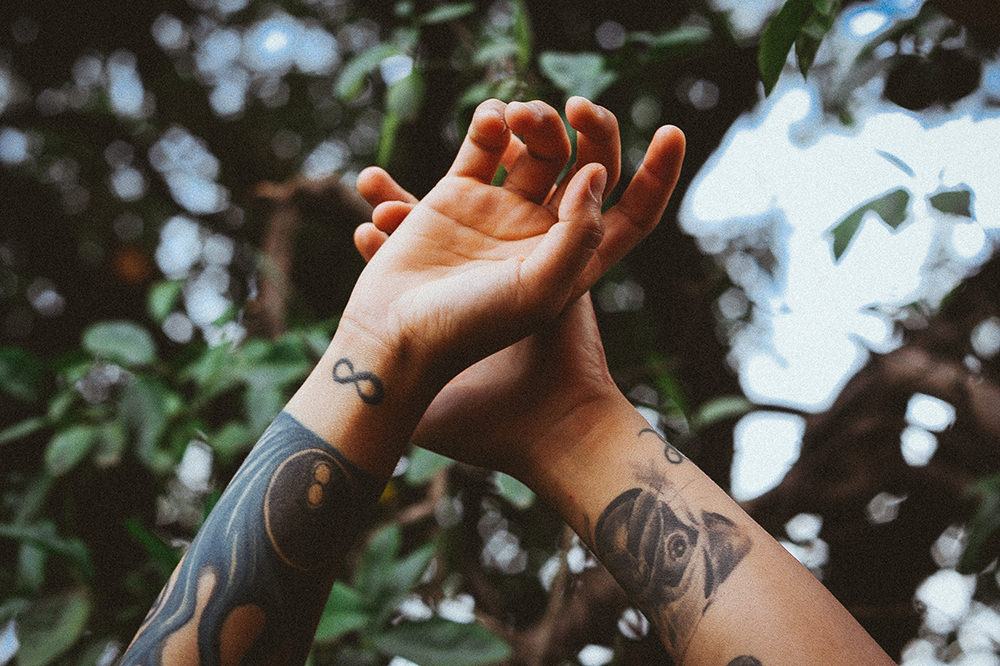
Love this, Dan. Mind. Body. Hands. Head. Heart. Verbal . Non verbal. All makes me want to read more. Kudos!